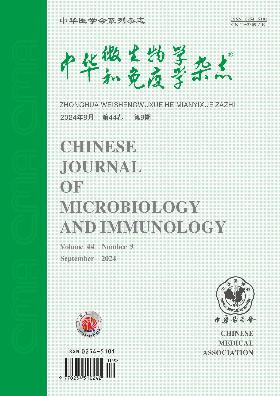Progress in cross-species transmission of human coronaviruses (HCoVs)
Q4 Immunology and Microbiology
引用次数: 0
Abstract
Coronaviruses (CoVs) are a group of ancient and common viruses, posing a severe threat to the health of humans and other animals. Currently, seven human CoVs (HCoVs) have been identified. They are all animal-derived zoonotic pathogens that jump the species barrier from their natural host animals to humans in a direct or indirect manner and lead to interpersonal transmission. The receptor binding domain (RBD) on the S1 subunit of CoV spike (S) protein is one of the key factors determining the cross-species transmission and the invasion potential. This review summarized and analyzed the transmission modes of seven HCoVs and the available structures of HCoV-RBD that mediated the cross-species transmission in order to better understanding the mechanism of CoV cross-species transmission and providing valuable knowledge in response to the potential cross-species transmission of novel CoVs in the future. Key words: Human coronavirus (HCoV); Spike (S) protein; C-terminal domain (CTD); Receptor binding domain (RBD); Cross-species transmission; Structure人类冠状病毒跨物种传播研究进展
冠状病毒是一组古老而常见的病毒,对人类和其他动物的健康构成严重威胁。目前,已经确认了7种人类冠状病毒。它们都是动物来源的人畜共患病原体,以直接或间接的方式跨越物种屏障,从自然宿主动物传播给人类,并导致人际传播。CoV刺突蛋白S1亚基上的受体结合域(RBD)是决定跨物种传播和入侵潜力的关键因素之一。本文综述和分析了7种HCoV的传播模式以及介导跨物种传播的HCoV RBD的可用结构,以更好地了解CoV跨物种传播机制,并为应对未来新型CoV潜在的跨物种传播提供有价值的知识。关键词:人类冠状病毒;刺突蛋白;C-末端结构域(CTD);受体结合域(RBD);跨物种传播;结构
本文章由计算机程序翻译,如有差异,请以英文原文为准。
求助全文
约1分钟内获得全文
求助全文
来源期刊

中华微生物学和免疫学杂志
Immunology and Microbiology-Virology
CiteScore
0.50
自引率
0.00%
发文量
6906
期刊介绍:
Chinese Journal of Microbiology and Immunology established in 1981. It is one of the series of journal sponsored by Chinese Medical Association. The aim of this journal is to spread and exchange the scientific achievements and practical experience in order to promote the development of medical microbiology and immunology. Its main contents comprise academic thesis, brief reports, reviews, summaries, news of meetings, book reviews and trends of home and abroad in this field. The distinguishing feature of the journal is to give the priority to the reports on the research of basic theory, and take account of the reports on clinical and practical skills.
 求助内容:
求助内容: 应助结果提醒方式:
应助结果提醒方式:


